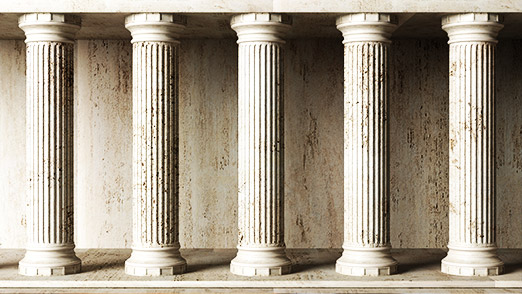Why do we have laws?
We have laws so society can work effectively to ensure that people or organisations cannot use power, money, or strength to take advantage of others or improve things for themselves. We have laws to ensure that everyone understands their rights and obligations and the rights and obligations of others.
What is a Legal System?
All countries have a legal system of some sort. The ‘legal system’ is a broad term that describes our laws, the process for making those laws, and the processes for ensuring the laws are followed. Our legal system reflects how we, as Australians, behave and how we as a country expect people, organisations and governments to behave toward each other.1
A business could not exist without the law. Businesses need laws to regulate their operations, settle disputes, and facilitate business transactions to operate efficiently and effectively. You must identify the legislative requirements that guide your practice as a bookkeeper or accountant in Australia and adjust business operations to ensure ongoing compliance with any legal changes that apply to your role.
The Australian legal system is founded on the concepts of the rule of law and justice and equality before the law. The three main principles of the legal system are fairness, equality before the law and justice. The legal system and lawmakers strive to achieve equal outcomes for all and equal protection of its citizens by making fair and just decisions.
Most people can understand effective laws, reflect the values of the majority of society and can be implemented effectively and quickly. Our governments, courts, judges, law enforcers and individuals continually strive to achieve equality, fairness and justice.
Equality means that everyone is treated the same, enjoys the same rights and opportunities, and no one is disadvantaged. In an equal society, everyone has the same opportunities to receive an education, gain employment and live comfortably.
There are many ways that we aim to ensure that all people have an opportunity to receive the same legal outcome regardless of any inequalities that exist in society. Anti-discrimination laws, affirmative action programmes, legal aid, dispute resolution procedures, and the use of interpreters are all methods that assist in creating equal and fair outcomes in a legal system.
Before we look at the laws that affect businesses, let's look at the Legal framework in Australia.
Australia is a federation of six states and two self-governing territories, which have their constitutions, parliaments, governments and laws. However, this has not always been the case.
For 50,000 years or more, Australia was inhabited by indigenous people. The indigenous people had their own rules and laws which governed how people behaved towards each other and the penalties that applied when these rules were broken. In 1788, the British arrived in Australia to establish a penal colony. They judged the land as uninhabited or 'terra nullius', ignoring indigenous laws and enacting the Doctrine of Reception, where the laws of England became the laws of the colony of New South Wales.
To learn more, you can use this map of Indigenous Australia.
Between 1855 and 1890, the British Parliament granted a limited right to set up a local system of government to each of the British colonies within Australia, usually referred to as granting 'responsible government'. As each colony was given this right, it could develop its laws and legal systems to deal with its particular situation. So, each colony's law and legal system began to develop separately.
During the late 19th century, there was a move towards creating a central government for the whole country. Representatives of the six colonies (New South Wales, Queensland, South Australia, Tasmania, Victoria and Western Australia) met at a series of conventions held in the 1890s to work on the wording of a constitution. The draft constitution was later approved by a vote of the people in referendums held in each colony.1
The Australian nation was established on 1 January 1901 following the passing of the Commonwealth of Australia Constitution Act by the United Kingdom Parliament.2

The Australian Constitution is a legal framework for how Australia is governed. It explains how laws are made and how power is distributed between the federal, state and territory governments, known as the division of powers. The Constitution also outlines the role of the federal Parliament and how the powers are shared between the legislature, executive and judiciary, known as the separation of powers.
The six foundation principles of the Australian Constitution are democracy, the rule of law, the separation of powers, federalism, nationhood and rights balanced by responsibilities. They interact with each other, providing checks and balances. Explore in detail how the six principles guide the people and the institutions within our system of government by clicking this link.
The Australian Constitution is divided into 8 Chapters and 128 Sections that outline how the Federal Parliament works and what powers it has.
- Chapter 1 covers the structure of the Australian Parliament
- The Queen as the head - represented by the Governor-General
- The Senate is the upper house, which consists of members elected from the states and territories. It was established to protect the interests of the states.
- The House of Representatives is the lower house, which consists of members elected to represent the people in one of Australia's 150 electorates.
- Chapter 2 covers the role of the executive government.
- Chapter 3 covers the role of the High Court of Australia (Judicature). This also includes:
- The Federal Court of Australia
- The Family Court of Australia
- The Federal Circuit Court of Australia.
- Chapter 4 covers Commonwealth finances and trade
- Chapter 5 covers the States
- Chapter 6 covers how new states or territories are established and the Federal Government's power to make laws for new states or territories. This includes:
- Ashmore and Cartier Islands
- Christmas Island
- Cocos and Keeling Islands
- Coral Sea Islands
- Jarvis Bay
- Norfolk Island
- Australian Antarctic Territory.
- Chapter 7 covers the establishment of the Seat of Government (Australian Capital Territory)
- Chapter 8 covers how the Constitution can be changed.
Read more about the Commonwealth of Australia Constitution Act.

The rule of law requires the use of power to be controlled by law. Division of power describes how the power to make laws in Australia is controlled.
Exclusive Powers
Exclusive Powers are powers granted to the federal Parliament exclusively. This power is limited by section 51 of the Australian Constitution.
Concurrent Powers
Concurrent Powers are powers the Commonwealth shares with the states and territories. This power is limited by section 109 of the Australian Constitution and includes:
- Education
- Health
- Taxation
- Environment
Residual Powers
Residual Powers are powers the states exclusively hold because the Constitution is silent on them, Section 107. These include local government, education and transport.
If the federal Parliament and a state parliament make laws about the same thing, but these laws don’t agree, the Australian Constitution says the federal law will be followed, and the state law will be removed.
The separation of powers describes how the law gives power to the arms of government in Australia. Power is balanced between:
- The Legislature (Parliament) can make and change the law. The Legislature, which includes the Houses of Parliament and the elected representatives, is responsible for drafting, debating and voting on new laws and amendments to existing laws. The Federal Parliament, which sits in Canberra, has two houses: the House of Representatives and the Senate. States and Territories are allocated seats in the House of Representatives based on the population of the state or territory.
- The Senate provides for proportional representation of states and territories. All states have 12 Senators, and territories have 2 Senators.
- The Executive has the power to put a law into action. The Governor-General has ultimate power over the Commonwealth of Australia. This power is usually exercised on the Executive Council's and its ministers' advice. The Governor-General gives royal assent to laws passed by the Legislature. It has 'reserve powers', one of which is to dismiss the Prime Minister, which is only used in exceptional circumstances.
- The Judiciary has the power to make judgements on the law. The Judiciary includes judges and the courts, which interpret the law when there is a legal dispute. Judges must make decisions based on the law and provide reasons. Judges have the power to make various orders to give effect to their decisions.3
Separation of Power under the Australian Constitution
There are many different levels of courts and tribunals in Australia. Each court has a specific function and deals with distinct matters at the federal and state levels. Chapter three of the Australian Constitution empowers Parliament to create federal courts and vest federal judicial power in state courts. The court's role is to administer the law and resolve disputes, and they have either criminal or civil jurisdiction.
Civil law refers to actions by one individual against another. In criminal law, there is a plaintiff (one who brings the charge) and a defendant (one against whom the charge is brought). A private individual or business usually initiates civil procedures. Government agencies may also be required to initiate civil actions against an individual or a corporation to enforce civil obligations arising under an Act or a contract. Remedies are usually awarded damages to the plaintiff if they can prove their claim on the balance of probability.
| Criminal law |
|
|---|---|
| Civil law |
|
Federal Court System

The High Court of Australia is the highest in the Australian Judicial system, originating in the Australian Constitution and the highest Court of Appeal. It interprets and applies the law of Australia, decides on the constitutionality of laws and hears final appeals in civil and criminal matters from all courts in Australia.
The Federal Court of Australia hears matters concerning bankruptcy, corporations, industrial relations, native title, taxation and trade practices laws and appeals from certain judgements of the Federal Circuit Court. The Court's jurisdiction is broad, covering almost all civil matters arising under Australian federal law and some summary and indictable criminal matters. This court hears appeals from decisions (except family law decisions) of the Federal Circuit Court.
This court hears cases about family disputes such as parenting issues, divorce and division of property. It also hears appeals from the Federal Circuit Court concerning family matters.
The jurisdiction of the Federal Circuit Court hears less complex disputes in family law and child support, administrative law, admiralty law, bankruptcy, copyright, human rights, industrial law, migration, privacy and trade practices. The court shares those jurisdictions with the Family Court of Australia and the Federal Court of Australia.4
State Court System

The table below explains the state and territory court hierarchy.
| State | Highest Court | Middle Court | Lowest Court |
|---|---|---|---|
| Australian Capital Territory | Supreme Court | Magistrates Court ACT Civil and Administrative Tribunal | |
| New South Wales | Supreme Court | District Court | Local Court – Small Claims and General Division NCAT Consumer Claims |
| Northern Territory | Supreme Court | Local Court – Small business claims | |
| Queensland | Supreme Court | District Court | Magistrate Court Queensland Civil and Administrative Tribunal (QCAT) |
| South Australia | Supreme Court | District Court | Magistrate Court |
| Tasmania | Supreme Court | Magistrate Court | |
| Victoria | Supreme Court | County Court | Magistrate Court Victorian Civil and Administrative Tribunal (VCAT) |
| Western Australia | Supreme Court | District Court | Magistrate Court |

Commonwealth Tribunals
Commonwealth tribunals conduct merits reviews of administrative decisions, which fall within administrative power, distinct from judicial power. Any exercise of judicial power by these tribunals would violate constitutional principles. Despite addressing legal questions, their primary function remains administrative decision-making. The separation of powers doctrine prohibits them from assuming judicial authority, ensuring a clear distinction between administrative and judicial functions.
State Tribunals
In the states of Australia, there's flexibility regarding the separation of powers, allowing non-court bodies to perform judicial functions if authorised by parliament. As a result, state tribunals often have a mixed role. They review administrative decisions and handle legal disputes, but typically on a smaller scale. For example, the Victorian Civil and Administrative Tribunal (VCAT) is the largest of its kind in Australia. While it primarily reviews administrative decisions in Victoria, it also handles legal disputes within its authorised scope. Similar hybrid tribunals exist in other states, reflecting this dual function.5
Government Bodies within Australia
The Australian government has used legislation to establish various government bodies which play a part in the Australian legal system. Some of the government bodies you may need to engage within your role as an accountant or bookkeeper are:
- Australian Taxation Office (ATO)
- Australian Securities and Investment Commission (ASIC)
- Australian Securities Exchange (ASX)
- Australian Competition and Consumer Commission (ACCC)
- The Tax Practitioners Board (TPB)
- Fair Work Ombudsman
Below, you will find a basic description of these government bodies. To find out more information, click on the corresponding links.
ATO
"The role of the Australian Taxation Office (ATO) is to ensure the community has confidence in the administration of Australia's taxation and superannuation systems.
They administer significant aspects of Australia's superannuation system, act as custodians of the Australian Business Register and manage business operations of the Australian Valuation Office." 6 – More information on the ATO can be found at the ATO website.
ASIC
ASIC is the Australian Securities and Investments Commission. They are Australia's corporate, markets and financial services regulators. They contribute to Australia's economic reputation and well-being by ensuring that Australia's financial markets are fair and transparent and supported by confident and informed investors and consumers.
ASIC regulates Australian companies, financial markets, financial services organisations, and professionals who deal with and advise on investments, superannuation, insurance, deposit taking, and credit.9 – More information on ASIC can be found on the ASIC website.
ACCC
The Australian Competition and Consumer Commission (ACCC) is an independent Commonwealth statutory authority whose role is to enforce the Competition and Consumer Act 2010 and a range of additional legislation, promoting competition, fair trading and regulating national infrastructure for all Australians. They aim to protect, strengthen, and supplement how competition works in Australian markets and industries, improve the economy's efficiency, and increase Australians' welfare.
This means they will take action where this improves consumer welfare, protects competition or stops conduct that is anti-competitive or harmful to consumers and promotes the proper functioning of Australian markets.7 – More information on ACCC can be found on the ACCC website.
ASX
ASX is an integrated exchange offering listings, trading, clearing, settlement, technical and information services, technology, data and other post-trade services. It acts as a market operator, clearinghouse, and payment system facilitator.
TPB
The Tax Practitioners Board (TPB) is responsible for registering and regulating tax agents, BAS agents, and tax (financial) advisers. It is also responsible for ensuring compliance with the Tax Agent Services Act 2009 (TASA), including the Code of Professional Conduct.
Fair Work Ombudsman
The Fair Work Ombudsman work with employees, employers and the community to educate and encourage compliance with Australia's workplace laws. They administer the Fair Work Act 2009 (FW Act) and the Fair Work Regulations 2009, which govern Australia's employee/employer relationship, provide a safety net of minimum entitlements, enable flexible working arrangements and fairness at work, and prevent discrimination against employees.8
